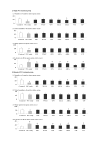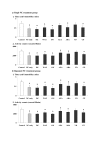Chronologically overlapping occurrences of nicotine-induced anxiety- and depression-related behavioral symptoms: effects of anxiolytic and cannabinoid drugs
- PMID: 17877812
- PMCID: PMC2075518
- DOI: 10.1186/1471-2202-8-76
Chronologically overlapping occurrences of nicotine-induced anxiety- and depression-related behavioral symptoms: effects of anxiolytic and cannabinoid drugs
Abstract
Background: Anxiety and depression are among the most frequently-observed psychiatric symptoms associated with nicotine (NC). In addition to the similarity to other addictive drugs, these NC-induced symptoms are characteristic in that the opposite behavioral effects, i.e. anxiolytic and antidepressant effects, which may reinforce the habitual use of NC, have also been reported. In the present study, the time course of anxiety- and depression-related behavioral alterations was examined in mice. Furthermore, based on the reported similarity in the mechanisms responsible for NC-induced anxiety- and depression-related symptoms, as well as the contribution of brain cannabinoid (CB) receptors to these behavioral symptoms, the effects of anxiolytics and CB receptor ligands (CBs) against these behavioral symptoms were investigated.
Results: Repeated subcutaneous NC treatments (0.3 mg/kg, 4 days), compared with a single treatment (0.5 mg/kg), caused both prolonged anxiogenic effects in the elevated plus-maze test, and prolonged depressive effects in the forced swimming test, even at 120 min time point after the last NC treatment. A transient anxiolytic preference for open arms was also observed in the elevated plus-maze test. Among the anxiolytics and CBs, the serotonin 1A (5-HT1A) antagonist WAY 100135 and the endogenous mixed CB agonist/antagonist virodhamine (VD), when administered intraperitoneally before each NC treatment, provided the strongest antagonistic effects against the anxiety-related symptoms. However, against the depression-related symptoms, only VD provided significant antagonistic effects in both single and repeated treatment groups.
Conclusion: The present results support the presence of a chronological overlap of NC-induced anxiety- and depression-related behavioral symptoms, and the contribution of brain CB receptors to these behavioral symptoms. The repeated NC-induced prolongation of these behavioral symptoms and the early transient anxiolytic behavioral alterations support an increased possibility of the habitual use of NC. Furthermore, based on the antagonistic effects of VD, one can predict that the characteristic effects on brain CB receptors as a mixed CB agonist/antagonist contributed to its therapeutic effects as both an anxiolytic and an antidepressant.
Figures




References
-
- West R, Hajek P. What happens to anxiety levels on giving up smoking? Am J Psychiatry. 1997;154:1589–1592. - PubMed
Publication types
MeSH terms
Substances
LinkOut - more resources
Full Text Sources
Medical

